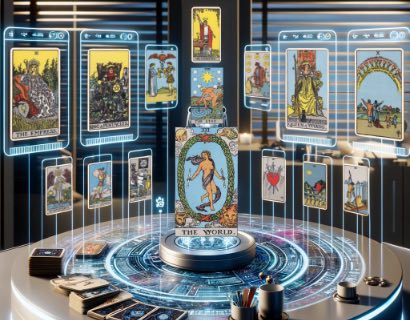|
Deck: Tarot Decoratif
by Ciro Marchetti. |
Created on Phuture Me |
Also available in our Tarot & Numerology App for Apple iOS & Android
 |
 |
Screenshot
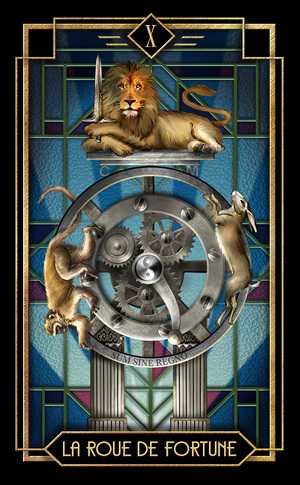
The wheel was intended to demonstrate the capricious nature of our fate. Power and material worth in a constant state of change beyond our control and decided instead by the fickle nature of the gods. The monkey and hare possibly symbolizing the tragic
comedy and ultimate futility of our attempts. Four states of fate are hinted at, the Lion at the top, is the current one, “I reign”. Enjoy it while you can I assume, because you will eventually fall, as the monkey who declares “I reigned” and your position will be replaced by another, the hare, declaring “I shall reign” The fourth figure is traditionally not shown and merely inferred to by its corresponding statement “I have no reign”. My only symbolic deviation on this card is the depiction of mechanical cogs and levers. A feature I’ve included on my previous decks also. It’s a personal take on the concept to ask us to consider that ultimately the wheel is also man made. And therefore suggests that rather than our lives being solely defined by the random spin of the wheel , that we do, via our own choices and responsibility for our actions, have some influence over the outcome. As I said though, this is a personal twist , feel free to pass.

The 5 of Wands, 5 of Rods or 5 of Batons is a card of conflict, struggle, tension and problems in the home or work place. The element here is Fire which relates to home, community, work & creativity. The aspects of the number 5 in numerology are change, the unexpected, discard, unattachment, adaptability and freedom. Opposing forces, all conflicting, is the main theme of this card the solution is one of adaptivity, change and dealing with the unexpected. THE PICTORIAL KEY TO THE TAROT; By Arthur Edward Waite (1911) A posse of youths, who are brandishing staves, as if in sport or strife. It is mimic warfare, and hereto correspond the Divinatory Meanings: Imitation, as, for example, sham fight, but also the strenuous competition and struggle of the search after riches and fortune. In this sense it connects with the battle of life. Hence some attributions say that it is a card of gold, gain, opulence. Reversed: Litigation, disputes, trickery, contradiction.
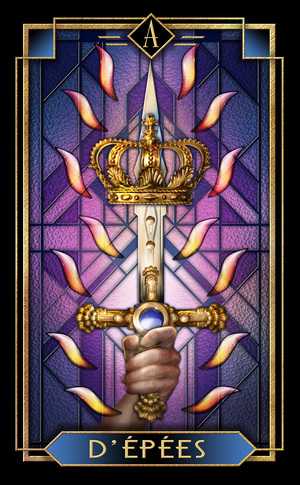
The Ace of Swords is traditionally represented as a single, upright, sword sometimes with it''s tip inside a crown or gold ring. It''s symbology is simple, it has the element of air and a numerological value of 1. As a 1 it represents a new beginning and, with air as the element, this beginning has to do with new challenges. This could be a contract, a legal letter, a problem needing addressing, new idea or intellectual focus. THE PICTORIAL KEY TO THE TAROT; By Arthur Edward Waite (1911) A hand issues from a cloud, grasping as word, the point of which is encircled by a crown. Divinatory Meanings: Triumph, the excessive degree in everything, conquest, triumph of force. It is a card of great force, in love as well as in hatred. The crown may carry a much higher significance than comes usually within the sphere of fortune-telling. Reversed: The same, but the results are disastrous; another account says--conception, childbirth, augmentation, multiplicity.
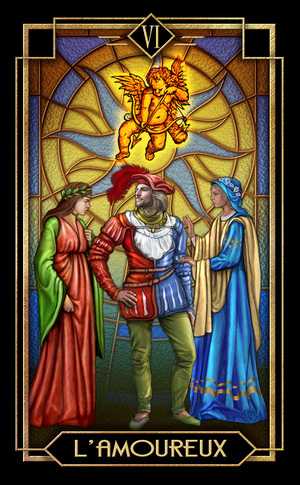
One of the more intriguing cards, depicted over the years with multiple variations. Specifically Cupid who seems somewhat undecided in who his target is from deck to deck and of course the principal difference of three figures in the TdM versus just the two in the WCS. So in terms of the Marseilles this brings up some interesting possibilities to explain the relationships between the three figures.
Clearly the presence of cupid indicates some romantic element, so unless we are being presented in the earlier decks with some medieval “ménage a trois”, there must be some other explanation. For me it makes sense if seen as a transition. The central male figure is depicted (in most decks) as looking at one of the two females and to me that suggests he has made a choice between the two. But not a choice between two lovers, but from two variations of love itself. He has reached a point in his life, he is moving on and literally turning away from a mothers love to that of a partner and by assumption his new life going forward. To better communicate this narrative, I have portrayed the female on the right as a more mature figure (the mother). In many decks she is shown with an outstretched hand touching him. This might suggest her gently and encouragingly letting go, or alternatively attempting to hold on. Nevertheless he looks towards the younger. It would appear his decision has been made, encouraged this time by a more accurate aim from cupids bow directed between the two.
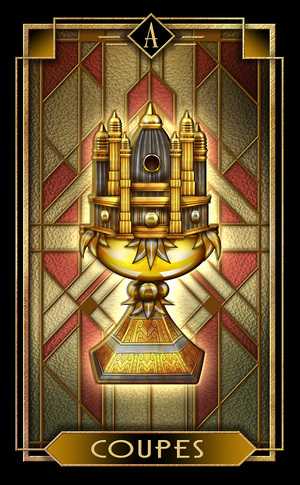
The Ace of Cups is traditionally represented as a single vessel filled with water. It''s symbology is simple, it has the element of water and a numerological value of 1. As a 1 it represents a new beginning and, with water as the element, this beginning is an emotional one. The card more commonly heralds the coming of a new acquaintance or friend. Since 1''s are, in numerology, singular it is unlikely to signify a romantic relationship. There are other cards which are more strongly associated with romantic relationship such as the 2 of Cups, the 10 of Cups or The Lovers. There maybe some reference here to the Christian symbology of the Holy Grail and it''s promise of spiritual re-birth and immortality. THE PICTORIAL KEY TO THE TAROT; By Arthur Edward Waite (1911) he waters are beneath, and thereon are water-lilies; the hand issues from the cloud, holding in its palm the cup, from which four streams are pouring; a dove, bearing in its bill a cross-marked Host, descends to place the Wafer in the Cup; the dew of water is falling on all sides. It is an intimation of that which may lie behind the Lesser Arcana. Divinatory Meanings: House of the true heart, joy, content, abode, nourishment, abundance, fertility; Holy Table, felicity hereof. Reversed: House of the false heart, mutation, instability, revolution.
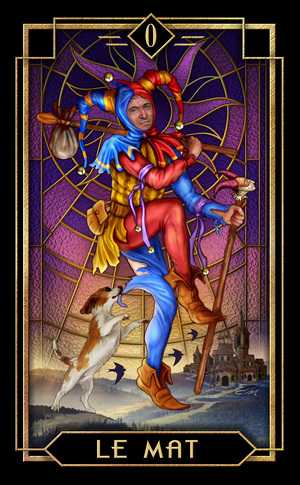
Holy man, innocent man, vagabond?
The WCS fool innocently leaping off the cliff, naively unaware of the inherent "foolishness" of such an act, serves as appropriate analogy for the start of the Fools journey through the major arcana and a metaphor for our own lives. Presumably gaining experience and understanding from the characters and scenarios the Fool (and we) will meet and interact with along the way. The companion dog connects the WCS to its Marseilles predecessors, yet clearly Pamela’s friendly little pooch, willingly following us in our "leap of faith" is not from the same litter or
shares similar intentions as his ancestor from the Marseilles, whose aggression strongly suggests the presence of the Fool to be an unwelcome one. His tearing of the Fools legging, is aimed at either preventing the Fools arrival, or encouraging his departure.
The Fool is an enigmatic figure that is referenced in many cultures and periods in history. A figure of both ridicule and begrudging respect, epitomized in Shakespeare's King Lear, the Fool enjoyed a physical access to and influence on the King. Arguably he also enjoyed the probably unique and envied privilege in court of being allowed to question or contradict a kings actions.
It has also been suggested that in medieval times wandering costumed fools may have been respected and honored, albeit cautiously, by the populace and considered holy men in the manner of those who piously and voluntarily rejected their material goods in exchange for a spiritual life. That sounds plausible enough in a general historical sense and thus in the Marseilles also, were it not for the aforementioned symbolism of the unfriendly dog. No matter who or what he was, the Fool would have been considered different and strange. He would have been misunderstood, qualifications that even today often trigger fear and rejection. I have added a small village scene and pathway in the background to emphasize both a physical distance and this social separation.
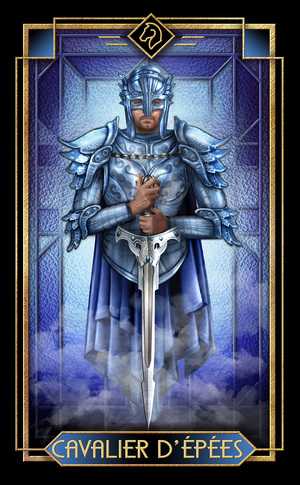
The Knight of Swords is young* man who has not reached maturity** yet. His vocation in life could be related to the element of air (pilot, air steward, meteorologist, etc), intellectual challenges (teacher, academic, scientist, lawyer, etc), surgical professions (dentist, doctor, nurse etc) or defence (soldier, policeman etc). The Swords offer a great range of possibilities of vocation in their symbolism. The symbolic relationship to this card may not be vocational, it could be a description of his personality. In which case this youth could be aggressive, argumentative, arrogant, authoritative, assertive, career minded or ambitious. His positive traits can be that he is brave and courageous or highly intelligent. He could even be someone who has spent time in prison or lives outside of the law. In the Rider-Waite-Smith Tarot The Knight is travelling on horse from east to west, the horse is charging at speed and the knight has his sword drawn in attack. It is important to note these details when divining who the symbology is talking about. This could, for example, mean a young man who is, or will be, aggressive or someone who comes from the East across wind swept and inhospitable lands. Finally, the symbology is never fixed in its interpretation as this card may not represent a person but a situation. For example it could be a warning about driving too fast or the need for immediate action and swift travel. *the age of this man could be relative to the person the reading is for. He maybe a mature man but a younger man. **maturity happens between ages 28 to 37, when a man enter''s his 2nd numerological life cycle. THE PICTORIAL KEY TO THE TAROT; By Arthur Edward Waite (1911) He is riding in full course, as if scattering his enemies. In the design he is really a prototypical hero of romantic chivalry. He might almost be Galahad, whose sword is swift and sure because he is clean of heart. Divinatory Meanings: Skill, bravery, capacity, defence, address, enmity, wrath, war, destruction, opposition, resistance, ruin. There is therefore a sense in which the card signifies death, but it carries this meaning only in its proximity to other cards of fatality. Reversed: Imprudence, incapacity, extravagance.
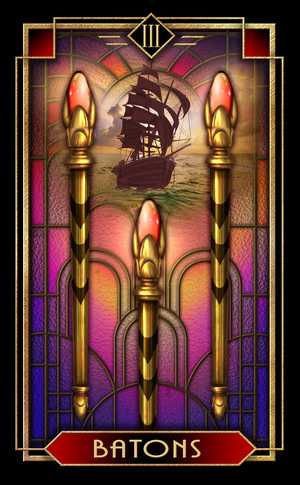
The 3 of Wands, 3 of Rods or 3 of Batons is a card of creativity in the home or work place through social engagement. The element here is Fire which relates to home, family, friends, work & creativity. The aspects of the number 3 in numerology are the joy of living, sociability, friendship, self expression and creativity. This card can point to working with others to create something new in the home or work place and this should be a successful and happy venture. THE PICTORIAL KEY TO THE TAROT; By Arthur Edward Waite (1911) A calm, stately personage, with his back turned, looking from a cliff''s edge at ships passing over the sea. Three staves are planted in the ground, and he leans slightly on one of them. Divinatory Meanings: He symbolizes established strength, enterprise, effort, trade, commerce, discovery; those are his ships, bearing his merchandise, which are sailing over the sea. The card also signifies able co-operation in business, as if the successful merchant prince were looking from his side towards yours with a view to help you. Reversed: The end of troubles, suspension or cessation of adversity, toil and disappointment.
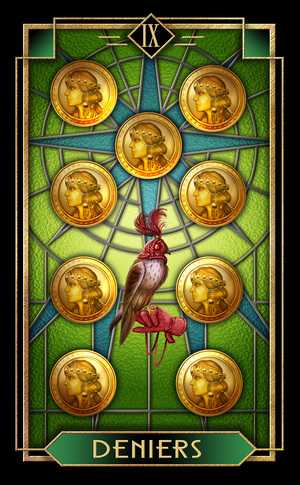
The 9 of Pentacles, or 9 of Coins, is a card of harvesting the work of the past and financially gaining from the fruits of labour or investment. The element here is Earth which relates to wealth and material possessions. The aspects of the number 9 in numerology are endings, completion of cycles, harvest time, charity and generosity. The number 9 is associated with The Moon, therefore this card can subtly warn of delusions, dreams and things not being all what they appear to be. It is time to reap what has been sown and tidy up. A time to cash in on the efforts of the past and clear the way for the beginning of the next cycle. The 9''s are also card''s of solitude and can indicate loneliness in the home or working alone. These financials rewards may well be enjoyed alone. THE PICTORIAL KEY TO THE TAROT; By Arthur Edward Waite (1911) A woman, with a bird upon her wrist, stands amidst a great abundance of grapevines in the garden of a manorial house. It is a wide domain, suggesting plenty in all things. Possibly it is her own possession and testifies to material well-being. Divinatory Meanings: Prudence, safety, success, accomplishment, certitude, discernment. Reversed: Roguery, deception, voided project, bad faith.

The 2 of Cups is a card of romantic relationships, love and gentleness. The element here is Water which relates to love and emotions. The aspects of the number 2 in numerology are love, gentleness, harmony, balance, adaptability, diplomacy and co-operation. In the Rider-Waite-Smith Tarot a man and a woman stand facing, holding a cup towards each other. In some other Tarot decks their arms may be crossed and they may also be drinking from the cups. This card is more commonly associated with a romantic relationship than a platonic one. The simple interpretation (& there are always many) is that this is a "date". The image could seen as couple courting. THE PICTORIAL KEY TO THE TAROT; By Arthur Edward Waite (1911) A youth and maiden are pledging one another, and above their cups rises the Caduceus of Hermes, between the great wings of which there appears a lion''s head. It is a variant of a sign which is found in a few old examples of this card. Some curious emblematical meanings are attached to it, but they do not concern us in this place. Divinatory Meanings: Love, passion, friendship, affinity, union, concord, sympathy, the interrelation of the sexes, and--as a suggestion apart from all offices of divination--that desire which is not in Nature, but by which Nature is sanctified.
Free AI Tarot Reading. Sample the Future!
Artificial Intelligence reads Tarot Cards so well you have to see it to believe it!
We'd love for you to try it for FREE and see for yourself why this excites us.
